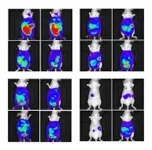Successful cancer therapy using artificial metalloenzymes to deliver drugs
2021-04-23
(Press-News.org) Researchers led by Katsunori Tanaka and Kenward Vong at the RIKEN Cluster for Pioneering Research (CPR) in Japan have demonstrated that tumor growth can be reduced by therapy that tags cancer cells with different therapeutic molecules. In one case, the group was able to prevent tumors from forming in mice by targeting cancer cells with a compound that makes it difficult for the cells to clump together and form tumors. For tumors that already existed, they targeted cancer cells with toxic compounds that destroyed them. This study was published on April 23 in Science Advances.
One of the major problems with current cancer treatments is that their effects are not limited to cancerous cells in the body. The side effects of chemotherapy are well known--hair loss, nausea, exhaustion, compromised immune system, and nerve damage. Being able to specifically target cancer cells--and only cancer cells--with therapeutic compounds is a dream that is slowly becoming a reality, and the new study by Tanaka's group at RIKEN CPR is the proof-of-concept. As Tanaka says, "We have succeeded for the first time in treating cancer using metal-catalyzed chemistry in mice."
The process builds on the group's previous work that uses artificial gold-based enzymes--generally called metalloenzymes--to tag proteins inside the body. The tagging agent and the metalloenzyme are both injected into the body, but separately. The metalloenzyme itself is designed to be glycosylated, meaning it has sugar chains called glycans attached to its surface. Specific glycans are chosen so that they can bind to the target cells in the body. For instance, different cancer cells can be identified by the unique types of lectins--glycan-binding proteins--that are embedded in their outer membranes. For this experiment, the researchers built a glycosylated metalloenzyme that would be able to attach itself to the specific lectins that are on the outside of HeLa cancer cells, thus targeting them. After the tagging agent reacts with the metalloenzyme, it can perform the desired function and tag the protein of interest on the cancer cell. In this way, only cancer cells targeted by the glycosylated metalloenzyme can be tagged.
The team performed two major targeted drug-delivery tests. The first test used a form of RGD that became functional after reacting with the artificial enzyme bound to the target cancer cell. RGD was chosen because prior testing indicated that it interferes with the ability of cancer cells to clump together and form tumors. They injected mice with HeLa cancer cells, and then injected them with both the glycosylated metalloenzyme and RGD. Control mice were injected with the artificial enzyme alone, RGD alone, or saline. The mice were monitored for 81 days. While all the controls developed tumors and died well before 81 days had been reached, the mice treated with the selective cell therapy with RGD tagging had a survival rate of 40%. Imaging analysis indicated that tumor onset and progression were disrupted by the treatment.
The second test was designed to attack tumors that had already formed. For this, the team used the same glycosylated metalloenzyme, but with a form of non-toxic doxorubicin that became functional after reacting with the metalloenzyme. Prior testing showed that the agent was harmless until it interacted with the metalloenzyme, at which time it released toxic doxorubicin. In this way, only targeted cancer cells were affected by the drug. Testing in mice was similar to testing with RGD, except that tumors were allowed to develop for a week before injecting the artificial enzyme and tagging agent. Mice receiving the real treatment showed reduced tumor growth and a higher survival rate over the course of 77 days.
"We were able to use our system to carry metalloenzymes to cancer cells in living mice, which reacted with tagging agents to deliver targeted drug therapies that reduced tumor onset and growth," says Tanaka. "The next step is certainly clinical application in humans."
INFORMATION:
Reference:
Vong et al. (2021) Disrupting tumor onset and growth via selective cell tagging (SeCT) therapy. Sci Adv. doi: 10.1126/sciadv.abg4038.
[Attachments] See images for this press release:

ELSE PRESS RELEASES FROM THIS DATE:
2021-04-23
An international team of researchers led by the University of Bergen has uncovered how organisms from crops to corals may avoid deadly DNA damage during evolution.
Our cells, and those of animals, plants and fungi, contain compartments that produce chemical fuel. These compartments contain their own DNA, which stores instructions for important cellular machinery. But this so-called oDNA (organelle DNA) can become mutated, corrupting the instructions and preventing cells making enough energy.
In humans and some other animals, a process called the "bottleneck" allows some offspring to inherit less mutated oDNA. This process needs mothers' egg cells to develop early, like in humans, where a human girl is born with all ...
2021-04-23
DURHAM, N.C. - Fruits and veggies are good for you and if you are a lemur, they may even help mitigate the effects of habitat loss.
A new study sequencing the genome of four species of sifakas, a genus of lemurs found only in Madagascar's forests, reveals that these animals' taste for leaves runs all the way to their genes, which are also more diverse than expected for an endangered species.
Sifakas are folivores, meaning that the bulk of their diet is composed of leaves. Leaves can be difficult to digest and full of toxic compounds meant to prevent them from being eaten. Unlike our carefully selected spinach, tree leaves also don't taste great, and are not very nutritious.
Because of that, leaf-eaters ...
2021-04-23
Strenuous efforts to prevent and treat malaria in recent decades have brought great benefits, particularly against disease caused by Plasmodium falciparum in countries in Africa and the Americas. But malaria caused by its "stealthier and more resilient cousin", P. vivax, now needs to be confronted with high priority, say Lorenz von Seidlein and Nicholas White of the Mahidol Oxford Tropical Medicine Research Unit in Bangkok, Thailand in a Perspective. The piece introduces a Collection on the prevention and treatment of P. vivax malaria in the open access journal PLOS Medicine, published ahead of World Malaria Day on April 25th.
In a Review article in the Collection, Sarah Auburn of the Menzies School of Health Research and Charles Darwin University, Darwin, Australia ...
2021-04-23
Extremist perpetrators of violence often quote verses from their religion's holy scriptures that authorize, or even prescribe, attacks on enemies of the faith. Abdullah H., the Syrian now on trial who stabbed a homosexual couple with a knife and killed a man in Dresden in October 2020, also testified that he had been inspired to commit the crime by a Quranic sura. However, whether the religious motivation that extremist perpetrators of violence emphasize is causally related to their actions is often doubted. Now, WZB researchers Ruud Koopmans and Eylem Kanol can prove for the first time that verses in religious scriptures that legitimize violence can increase support for killing enemies of the faith.
Together with Dietlind Stolle, a German-Canadian ...
2021-04-23
In a rare exchange, scientists and water resources engineers from Iran and Utah are collaborating on a bold scientific study to restore one of the world's largest saline lakes.
Lake Urmia -- a massive salt lake in Iran's northwest and a sister to Utah's Great Salt Lake -- has lost nearly 95 percent of its volume over the last two decades. As water levels drop, salinity spikes, threatening the lake's brine shrimp population and the flamingos and other bird species that depend on the shrimp for food. Lake levels are so low that at some coastal resorts, tourism boats must be pulled a kilometer (0.6 mile) or more from shore by tractor before reaching suitable depths. In addition, new land bridges are forming in the drying lake bed which allows mainland predators ...
2021-04-23
Over the last 60 years, scientists have been able to observe how and when genetic information was replicated, determining the existence a "replication timing program", a process that controls when and in what order segments of DNA replicate. However, scientists still cannot explain why such a specific timing sequence exists. In a study published today in Science, Dr. David Gilbert and his team have answered this 60-year-old question.
"Why would cells care about the order in which they replicate DNA?" asked lead scientist Dr. Gilbert. "After all - all cells need to replicate all their DNA. Our hypothesis has been ...
2021-04-23
A lobster's underbelly is lined with a thin, translucent membrane that is both stretchy and surprisingly tough. This marine under-armor, as MIT engineers reported in 2019, is made from the toughest known hydrogel in nature, which also happens to be highly flexible. This combination of strength and stretch helps shield a lobster as it scrabbles across the seafloor, while also allowing it to flex back and forth to swim.
Now a separate MIT team has fabricated a hydrogel-based material that mimics the structure of the lobster's underbelly. The researchers ran the material through a battery of stretch and impact tests, and showed ...
2021-04-23
What The Study Did: This simulation modeling study estimates the benefits of identifying silent COVID-19 infections among children as a proxy for their vaccination.
Authors: Alison P. Galvani, Ph.D., of the Yale School of Public Health in New Haven, Connecticut, is the corresponding author.
To access the embargoed study: Visit our For The Media website at this link https://media.jamanetwork.com/
(doi:10.1001/jamanetworkopen.2021.7097)
Editor's Note: The article includes conflict of interest and funding/support disclosures. Please see the article for additional information, including other authors, author contributions and affiliations, conflict of interest and financial disclosures, ...
2021-04-23
What The Study Did: Baseline corrected QT interval (QTc) on 12-lead electrocardiograms and ensuing changes among patients with and without COVID-19 are evaluated in this study.
Authors: Marc P. Waase, M.D., Ph.D., and Elaine Y. Wan, M.D., of the Columbia University Irving Medical Center in New York, is the corresponding author.
To access the embargoed study: Visit our For The Media website at this link https://media.jamanetwork.com/
(doi:10.1001/jamanetworkopen.2021.6842)
Editor's Note: The article includes conflict of interest and funding/support disclosures. Please see the article for additional information, including other authors, author contributions and affiliations, conflict of interest and financial disclosures, and funding ...
2021-04-23
What The Study Did: This study examines the test result positivity rate and health outcomes of maternal SARS-CoV-2 infection among perinatally exposed newborns.
Authors: Asimenia Angelidou, M.D., Ph.D., of Beth Israel Deaconess Medical Center in Boston, is the corresponding author.
To access the embargoed study: Visit our For The Media website at this link https://media.jamanetwork.com/
(doi:10.1001/jamanetworkopen.2021.7523)
Editor's Note: The article includes conflict of interest and funding/support disclosures. Please see the article for additional information, including other authors, author contributions and affiliations, conflict of interest and financial ...
LAST 30 PRESS RELEASES:
[Press-News.org] Successful cancer therapy using artificial metalloenzymes to deliver drugs





